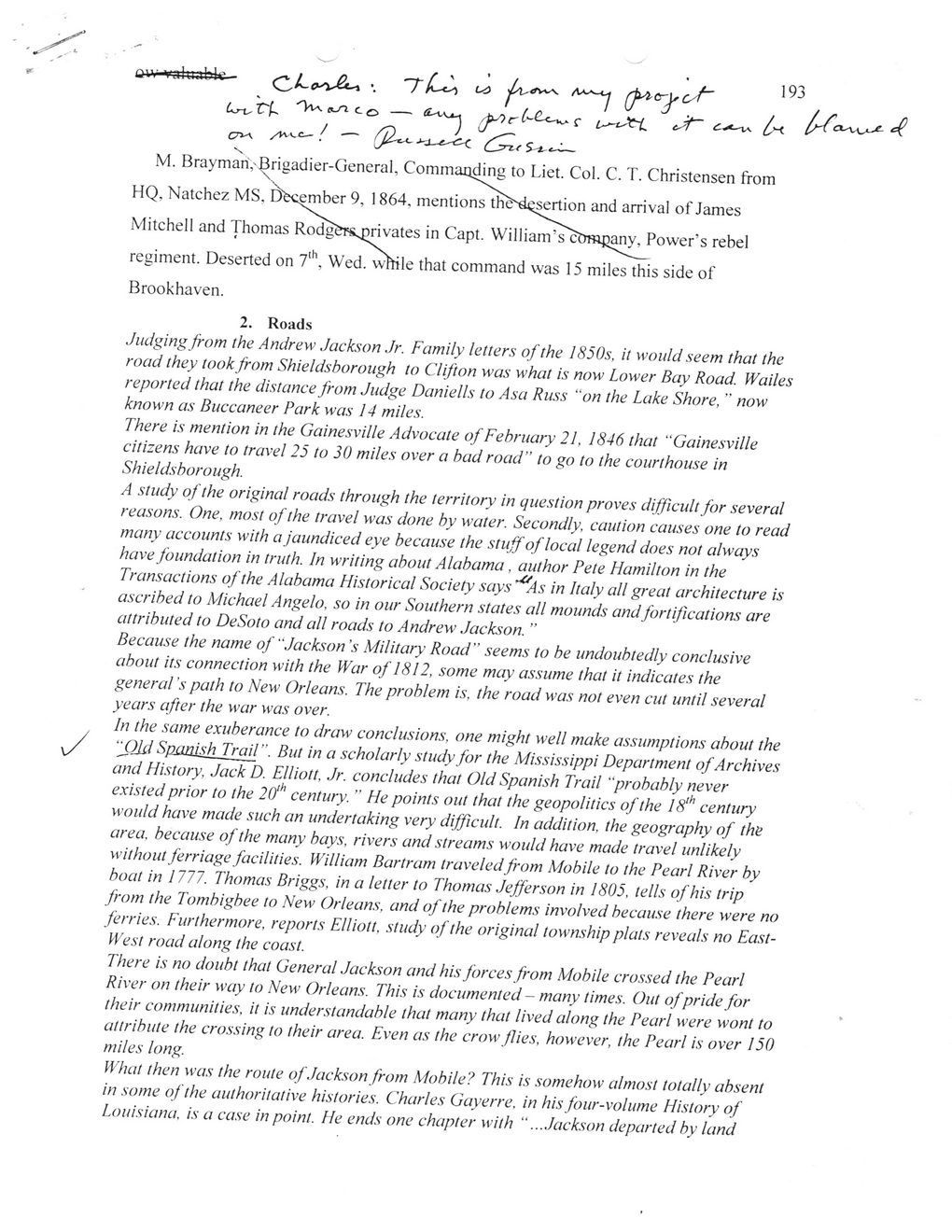This text was obtained via automated optical character recognition.
It has not been edited and may therefore contain several errors.
aw "'ahnhk <ZLosj2^ J* ^yO- 193 Lru H- 'Via^cc — cJf~ <c-*-nA l*< N. M. Braymari, Brigadier-General, Commanding to Liet. Col. C. T. Christensen from HQ, Natchez MS, Dfecmnber 9, 1864, mentions tn^d^sertion and arrival of James Mitchell and Thomas Rodg&Tessprivates in Capt. William’sctmimny, Power’s rebel regiment. Deserted on 7th, Wed. while that command was 15 miles this side of Brookhaven. 2. Roads Judging from the Andrew Jackson Jr. Family letters of the 1850s, it would seem that the road they took from Shieldsborough to Clifton was what is now Lower Bay Road. Wailes reported that the distance from Judge Daniells to Asa Russ “on the Lake Shore, ” now known as Buccaneer Park was 14 miles. There is mention in the Gainesville Advocate of February 21, 1846 that “Gainesville citizens have to travel 25 to 30 miles over a bad road” to go to the courthouse in Shieldsborough. A study of the original roads through the territory in question proves difficult for several reasons. One, most of the travel was done by water. Secondly, caution causes one to read many accounts with a jaundiced eye because the stuff of local legend does not always have foundation in truth. In writing about Alabama, author Pete Hamilton in the Transactions of the Alabama Historical Society says ~°As in Italy all great architecture is ascribed to Michael Angelo, so in our Southern states all mounds and fortifications are attributed to DeSoto and all roads to Andrew Jackson. ” Because the name of “Jackson's Military Road ” seems to be undoubtedly conclusive about its connection with the War of 1812, some may assume that it indicates the general’s path to New Orleans. The problem is, the road was not even cut until several years after the war was over. In the same exuberance to draw conclusions, one might well make assumptions about the "JUil Spanish Trail’’. But in a scholarly study for the Mississippi Department of Archives and History, Jack D. Elliott, Jr. concludes that Old Spanish Trail “probably never existed prior to the 20lh century. ” He points out that the geopolitics of the 18th century would have made such an undertaking very difficult. In addition, the geography of the area, because of the many bays, rivers and streams would have made travel unlikely without ferriage facilities. William Bartram traveled from Mobile to the Pearl River by boat in 1777. Thomas Briggs, in a letter to Thomas Jefferson in 1805, tells of his trip from the Tombigbee to New Orleans, and of the problems involved because there were no ferries. Furthermore, reports Elliott, study of the original township plats reveals no East-West road along the coast. There is no doubt that General Jackson and his forces from Mobile crossed the Pearl River on their way to New Orleans. This is documented - many times. Out of pride for their communities, it is understandable that many that lived along the Pearl were wont to attribute the crossing to their area. Even as the crow flies, however, the Pearl is over 150 miles long. What then was the route of Jackson from Mobile? This is somehow almost totally absent in some of the authoritative histories. Charles Gayerre, in his four-volume History of Louisiana, is a case in point. He ends one chapter with “ ...Jackson departed by land

Old Spanish Trail Document (058)